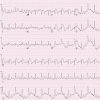Brugada Pattern Phenocopy Induced by Diabetic Ketoacidosis
- PMID: 34141510
- PMCID: PMC8206546
- DOI: 10.7759/cureus.15066
Brugada Pattern Phenocopy Induced by Diabetic Ketoacidosis
Abstract
Brugada syndrome is a congenital cardiac channelopathy characterized by ST-segment elevation (≥2 mm) and subsequent inverted T wave in a minimum of two right precordial leads (Brugada type 1 ECG [electrocardiogram] pattern) on ECG. Brugada syndrome is estimated to be responsible for 4%-12% of all sudden cardiac deaths and up to 20% in patients with structurally normal hearts. Development of a temporary Brugada pattern, known as Brugada phenocopy, has been observed in individuals presenting with reversible underlying conditions such as hyperkalemia, hyponatremia, acidosis, ischemia, and pulmonary embolism, among others. Herein we present a case of Brugada phenocopy seen in a patient in diabetic ketoacidosis, which resolved after the electrolyte abnormalities were corrected.
Keywords: brugada pattern; brugada phenocopy; brugada syndrome; dka; phenocopy.
Copyright © 2021, Landa et al.
Conflict of interest statement
The authors have declared that no competing interests exist.
Figures
References
-
- Brugada syndrome: a decade of progress. Antzelevitch C, Brugada P, Brugada J, Brugada R, Shimizu W, Gussak I, Perez Riera AR. Circ Res. 2002;91:1114–1118. - PubMed
-
- Cellular basis for the electrocardiographic J wave. Yan GX, Antzelevitch C. Circulation. 1996;93:372–379. - PubMed
-
- Natural history of Brugada syndrome: insights for risk stratification and management. Priori SG, Napolitano C, Gasparini M, et al. Circulation. 2002;105:1342–1347. - PubMed
-
- Autonomic and antiarrhythmic drug modulation of ST segment elevation in patients with Brugada syndrome. Miyazaki T, Mitamura H, Miyoshi S, Soejima K, Aizawa Y, Ogawa S. J Am Coll Cardiol. 1996;27:1061–1070. - PubMed
-
- Electrocardiographic pattern simulating acute myocardial injury. Osher HL, Wolff L. https://pubmed.ncbi.nlm.nih.gov/13104407/ Am J Med Sci. 1953;226:541–545. - PubMed
Publication types
LinkOut - more resources
Full Text Sources


